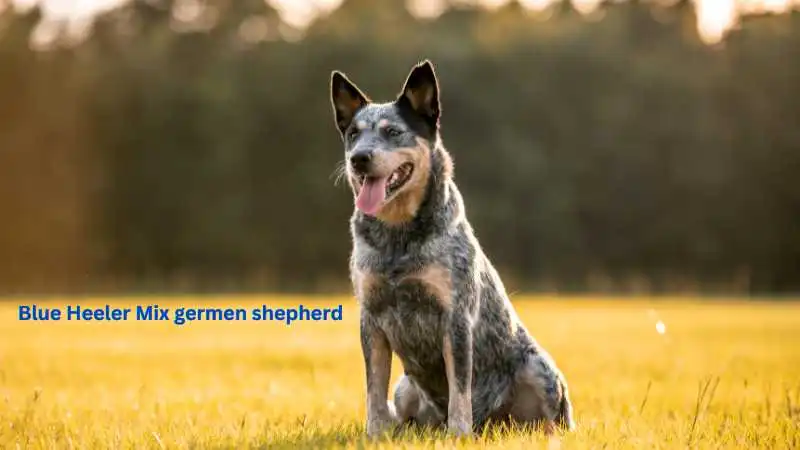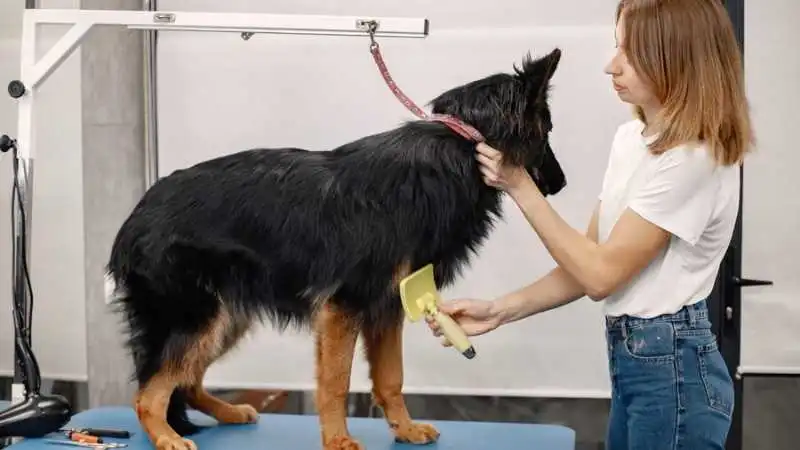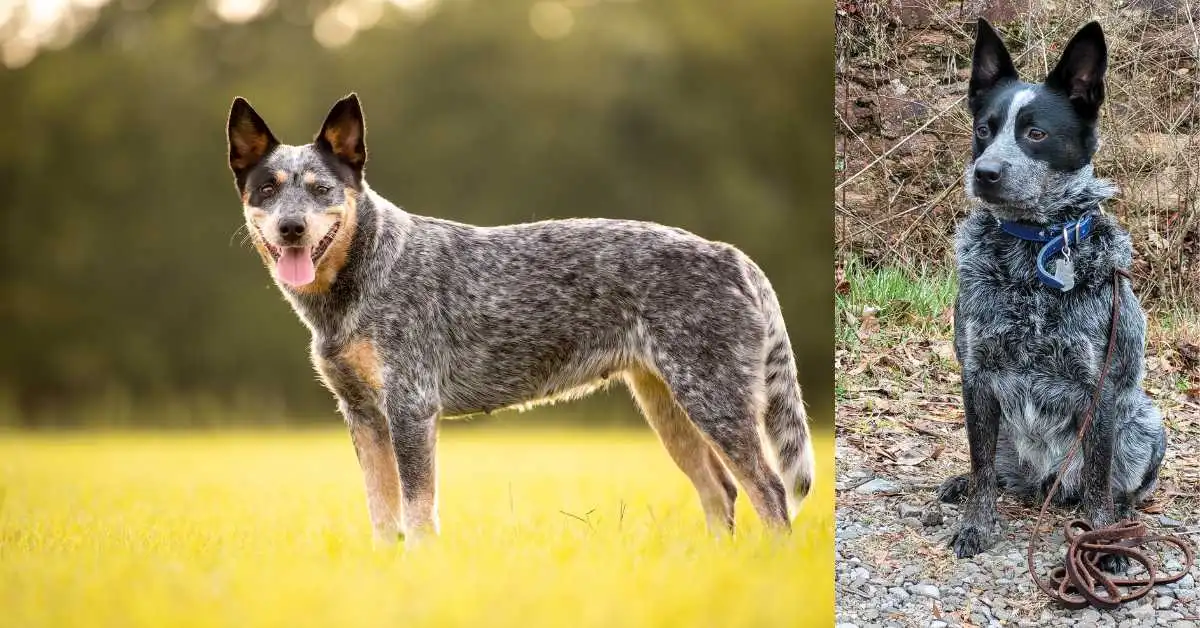The German Shepherd Blue Heeler mix is an impressive and intelligent hybrid dog that combines two hardworking breeds: the German Shepherds and the Blue Heeler (often known as the Australian Cattle Dog).
Known for their loyalty, energy, and protective instincts, these dogs make excellent companions, especially for active families or individuals who enjoy outdoor activities. They typically have a strong, muscular build and a coat that may display the Blue Heeler’s distinctive speckled pattern or a blend of the German Shepherd’s colors.
Highly trainable, the German Shepherd Blue Heeler mix thrives on regular physical and mental engagement to stay content and healthy. With sharp instincts and a deep bond with their owners, these dogs are ideal for those seeking a loyal, versatile companion.
| Height: | 20-25 inches |
|---|---|
| Weight: | 45-80 pounds |
| Lifespan: | 11-14 years |
| Suitable For: | Active families or those looking for a working dog with lots of energy |
| Temperament: | Energetic, loyal, brave, and obedient |
What truly sets this canine apart is its ability to adapt and excel in various roles, whether as a family companion or a working dog. Its intelligence and loyalty make it a trustworthy partner, always ready to engage in activities challenging the mind and body. As someone who has spent considerable time around these dogs, I can attest to their unique blend of traits that make them both a joy and a challenge to raise.
Where do they come from?
In delving into the origins of the Blue Heeler German Shepherd Mix Puppy, it’s fascinating to trace the lineage of both parent breeds. The German Shepherd, known for its fierce loyalty, intelligence, and agility, has maintained its status as a working dog even as commercial husbandry evolved. Originally bred for herding, the German Shepherd found a new niche in law enforcement, where its attributes were highly valued.
On the other side of the world, in Australia, the Blue Heeler was being developed for a similar purpose: herding cattle. But the Blue Heeler’s journey was unique, involving a complex mix of breeds such as the Collie, Dalmatian, Black and Tan Kelpie, and the native Dingo. This mix contributed to the breed’s robustness and adaptability, which are now inherent in the Blue Heeler German Shepherd Mix.
Reflecting on my personal experiences with these breeds, it’s evident how their herding roots have profoundly influenced their modern-day characteristics.
The German Shepherd’s role in law enforcement is a testament to its adaptability and skill, while the Blue Heeler’s diverse genetic makeup showcases its versatility. Together, they create a mix that is as capable and intelligent as loyal and agile, making the Blue Heeler German Shepherd Mix a remarkable canine companion.
German Shepherd Blue Heeler Mix
Appearance

The Blue Heeler German Shepherd Mix is a striking embodiment of both German Shepherds and Blue Heelers, inheriting traits like bravery, strength, intelligence, athleticism, loyalty, and protectiveness. Often sought after as guard dogs, these hybrid offspring showcase an impressive blend of characteristics from the Blue Heeler and German Shepherd crosses.
From my observation, this intelligent dog is adept at playing and working and has a penchant for digging holes in the yard or exploring with their powerful canines. Their appearance is characterized by a lean face and upright ears, with a coat that often exhibits a unique blue hue amidst black and brown fur.
This big dog boasts a solid build, reflecting the Australian Cattle Dog’s stocky frame, yet they are often taller and longer, measuring about 18 to 26 inches tall and weighing between 35 and 90 lbs.
A key aspect of their well-being is ample physical and mental stimulation to keep them happy. The absence of such engagement can turn their boredom into a destructive force. Additionally, as a vocal dog, the Heeler Shepherd cross may express itself through barking, especially when its intelligent and energetic nature is not adequately channeled.
Grooming of German Shepherd and Blue Heeler Mix Dogs
Grooming a Blue Heeler German Shepherd mix is unique due to their double coat. While the Blue Heeler typically requires minimal grooming, the German Shepherd’s longer coat in this hybrid means they tend to shed more, especially the undercoat, during moist seasons like springtime. As an owner, I’ve found that brushing the dog’s hair daily during shedding is crucial. Using a bristle brush can be gentle on their sensitive skin.
If your pup gets dirty, it’s better to opt for high-quality, deodorizing wipes rather than frequent baths, which can lead to dry skin. Their skin remains conditioned with this less-invasive cleaning method.
In addition to coat care, brushing their teeth several times a week is essential to keeping them clean. Checking and cleaning their ears once a week is also necessary to ensure their nails are clipped regularly to avoid them becoming uncomfortable for too long.
Through my experience, I’ve learned that consistent grooming maintains the physical health of your Blue Heeler German Shepherd mix and strengthens the bond between you and your dog.
Temperament Traits
The Cattle Shepherd mix, a blend of the Blue Heeler and German Shepherd, is known for its loyal temperament and high energy. It is ideal for active families, particularly those with older children. These dogs are brilliant, which facilitates training, but owners must be persistent and strong-willed to match their dog’s temperament.
Socialization from an early age is crucial to mitigating issues with children, strangers, and other pets. They may bark as a natural response to unfamiliar situations, so obedience classes are beneficial.
This mix is unsuitable for city or apartment living. They thrive in environments with land to patrol and property to guard. These dogs require ample exercise; a tiny apartment with limited room to move freely could lead to frustration and pent-up energy. Families with spacious homes or access to large outdoor areas will find these dogs loyal and active companions, always eager to engage and protect.
Do they make good family dogs?

Determining whether the Blue Heeler German Shepherd Mix is a good family pet depends largely on the right situation. They can be okay with children, provided interactions are supervised. The Blue Heeler side tends to herd, which might manifest as nipping, a behavior to be mindful of around young kids. There’s a potential for aggression on the GSD side, but with proper training, this rarely turns into a problem.
These dogs can be incredibly loving and fiercely loyal, making them excellent companion dogs. They naturally protect their family and can be effective watchdogs. However, they are best suited for experienced owners who can provide consistent training and understand the unique needs of this hybrid. A Blue Heeler-German Shepherd mix can be an excellent family addition with the proper guidance and environment.
Health Problems in German Shepherd Blue Heeler Mix

While the German Shepherd mixed with Blue Heeler is generally a healthy dog with a lifespan of 7 to 16 years, as a mixed-breed puppy, they are still at risk and can be susceptible to certain health problems.
Both parents have specific predispositions that prospective owners should be on the lookout for. Key symptoms to monitor include those related to bloat, elbow dysplasia, and hip dysplasia, which are familiar in large breeds like the German Shepherd.
Additionally, skin conditions like eczema, neurological issues such as epilepsy, and sensory deficits, including blindness, eye disorders, or deafness, are also potential concerns.
Regular veterinary check-ups and being vigilant about any changes in your pet’s health can go a long way in ensuring their well-being. Early detection and intervention can significantly improve the quality of life for these dogs, allowing them to enjoy their entire lifespan alongside their families.
Food Requirements for German Shepherd Blue Heeler Mix Dogs
Feeding a Blue Heeler-German Shepherd mix requires paying attention to their dietary needs. These active dogs should eat 2-3 meals a day to stay healthy. A high-quality dog food, around 2-3 cups daily, is ideal. Adding fish oil and vitamins can help keep their coat shiny and boost their immune system.
Some great dog food options include Hill’s Science Diet, Taste of the Wild, and Blue Buffalo Life Protection Formula. These brands offer balanced nutrition with ingredients like lean meats, sweet potatoes, and fruits, which are great for digestion and overall health. Supplements like Nutra Thrive can also support their well-being and potentially extend their lifespan.
As a responsible owner, choosing the right food and supplements is key to keeping your dog happy and healthy.
3 Reasons Not to Get One
Choosing a Blue Heeler-German Shepherd mix is a big decision. Here are a few things to consider:
- High Energy Levels: Both breeds are very active and need plenty of exercise and mental stimulation. Without it, they can become bored and destructive.
- Grooming Needs: This mix tends to shed a lot, especially in spring, so regular brushing is a must to keep their coat under control.
- Not Ideal for All Homes: Their high energy and strong herding instincts might not be a good fit for families with small kids, small pets, or other animals.
While they can be amazing companions, make sure your lifestyle and home environment are a good match for this energetic and high-maintenance breed.
A German Shepherd mix with a Blue Heeler puppy is for sale
When considering purchasing a German Shepherd/Blue Heeler mix puppy, selecting a legitimate breeder with a good reputation is crucial. A reliable breeder will happily accommodate your request to meet both the parent dogs and see where the puppies are raised.
This meeting can help you gauge whether the puppies are the proper canine companions for your family and ensure their health is a priority. Look for clean kennels with ample space for puppies to romp; these are signs of a breeder who cares about their business and animals.
For those searching online, websites like Greenfield Puppies, Lancaster Puppies, Buckeye Puppies, Breed Your Dog, and K9Stud list private and professional breeders who sell puppies and offer stud services. Alternatively, adopting from rescue organizations or your local animal shelter can be a rewarding experience.
Websites like www.aspca.org, www.aforeverhome.org, www.texas cattle dog rescue.com, www.mill dog rescue.org, and www.pawsandprayers.org are great resources for finding a German Heeler for adoption. Whether buying or adopting, ensure you’re prepared to welcome this unique breed into your home.
Final thoughts
The German Shepherd Blue Heeler mix is a smart, loyal, and energetic dog that loves staying active. They make great pets for families who enjoy outdoor adventures.
While they’re generally healthy, keep an eye out for potential issues like hip or eye problems. With proper care, training, and plenty of exercise, this mix can be a loving and fun addition to your family. If you’re looking for a friendly, hardworking dog, the German Shepherd Blue Heeler mix is a fantastic choice.
FAQs
What is a Blue Heeler German Shepherd Mix?
A Blue Heeler-German Shepherd Mix is a unique crossbreed that comes from breeding a Blue Heeler (also known as an Australian Cattle Dog) with a German Shepherd.
What do you call a German Shepherd and Blue Heeler mix?
A mix between a German Shepherd and a Blue Heeler is often called a Cattle Shepherd. This name reflects the herding and protective qualities of both breeds. The Cattle Shepherd inherits the German Shepherd’s intelligence and loyalty, along with the Blue Heeler’s energy and agility.
How do Blue Heeler and German Shepherd mixes get along with children and other pets?
Blue Heeler-German Shepherd mixes can be wonderful family pets. They are usually good with children and other pets, especially if they are properly socialized from a young age. Their protective and loyal nature, inherited from the German Shepherd, combined with the Blue Heeler’s friendly and energetic personality, makes them well-suited for families.
